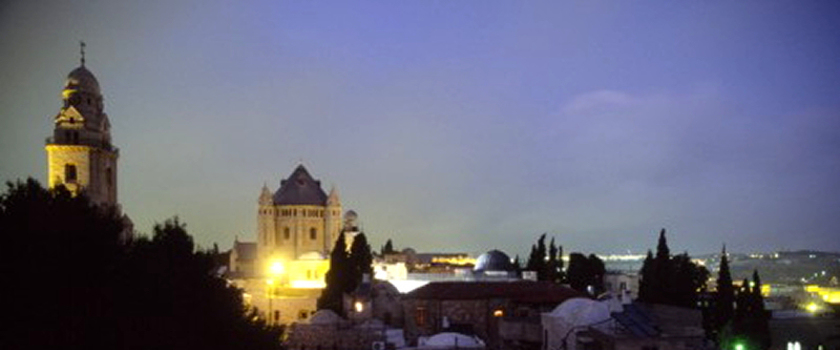 Dormition Abbey on Mount Zion.
Dormition Abbey on Mount Zion.
Mount Zion located just south of the Old City of Jerusalem, is for Jews, Christians and Muslims, for both those who think religiously and politically, a place dense with significance. Memories and hopes, ancient stories and visions are bound up with this hill – and leave their mark on our community.
Mount Zion - a hill through the ages
Whoever says “Zion”, allows the strings of an instrument to sound, which tell of unification and gathering, of the task and mission of the people of God, of the one people of God.
Geographically the designation has moved: first it was connected with the hill to the southeast, on which the city of the Jebusites lay, which David conquered over three thousand years ago as “Fortress Zion”(1 Chr 11:15). From there it was extended to the north, to the area of the later Jewish temple. “Zion” is now the synonym for the presence of God and the choice of the people of Israel.
So it is hardly surprising that “Zion” was then equated with Jerusalem and then with the whole land, and that finally it came to designate that political movement of the 19th century seeking the return of Jews from the whole world to the land of their ancestors, which is called “Zionism.”
However, earlier in the Crusader period, the designation “Zion” in the narrower sense had moved to the hill in the Southwest of the present day Old City, because at that time the ancient city of David was thought to have been located on this hill. To this idea even today the Arabic designation of the building complex next to ours bears witness: Nebi Daoud - “(grave of the) Prophet David.” Here the tomb of the legendary King David was venerated in past centuries by the Muslim faithful and following them even today by the Jewish faithful.
Mount Zion - Hill of the Encounter with Christ
In the Christian tradition Mount Zion plays a big role as the meeting place of Jesus’ disciples. In the so-called “Upper Room” Jesus celebrates the Last Supper before his passion and death. It is located and venerated in the building complex of the “Cenacle,” on the ground floor of which lies the tomb of David.
Place of the Encounter with Jesus
On that evening Jesus entrusts himself to his disciples under the sign of bread and wine: his life and his message of devotion and love, his death and the promise of a new, everlasting and perfect life in his name. That his sacrifice means something basically different from the incense and burnt-offerings in the Old Testament temple, becomes clear in the sign of the foot washing: just as Jesus washes the feet of his disciples, bends down to their feet, so we too should turn to one another and be present for one another.
That his bloody death was not simply magically cancelled and eliminated in his Resurrection, Jesus makes clear, when he appears in the circle of his disciples, who have once again gathered together on Zion. Jesus shows them his wounds. He is the one who died on the cross. The new life in God takes our wounds seriously also and does not deny them. Rather Jesus, marked by human violence, grants peace to his disciples. - For us this is a daily gift and task, a present and a challenge.
For the encounter with Jesus in the celebration of the Eucharist, in the washing of the feet, and in the belief in the Resurrection is not restricted to the inner circle of the disciples or of the monastic community: this encounter seeks a way into the world and to mankind. God remains among us humans. That is the experience of the disciples at Pentecost, as they are again gathered together in prayer on Zion.
The Birthplace of the Church
The Zion of Pentecost is thus the birthplace of the Church, for from here the apostles spread out into the whole world to announce the message of Jesus. Like a pulse beat there begins in that moment the great basic movement that marks the life of every individual Christian: from the turning to God and the encounter with Him grows the movement toward our neighbor and toward the world. Yet the encounter with the neighbor and the world, our service for people and their needs, remains empty and unfulfilled in the long run, if we do not constantly turn back to that initial spiritual impulse and allow ourselves to be filled anew and led by God's Spirit.
Mary's Place of Death
When Mary, the mother of Jesus, lay dying, the apostles find their way back to Zion from their missionary journeys. In our “house icon” they are seen standing around Mary's death bed. Above the thus assembled original community, a symbol also for the Church in our days, one sees in this icon Christ as the exalted ruler of the universe. In his hands he carries the soul of Mary, wrapped like a baby in swaddling clothes, up to heaven. - A image and an assurance that all life will find its completion in God.
Thus it is Christ who stands in the center of our Marian church. With the apostles and the pilgrims, we share bread and wine, learn how Christ bends down to us. With the pilgrims, the apostles and Mary we pray for the gifts of the Holy Spirit. With Mary we look forward to our completion. - As pilgrims we here on Zion are on this path. Out into the world. Into the eternal presence of God.